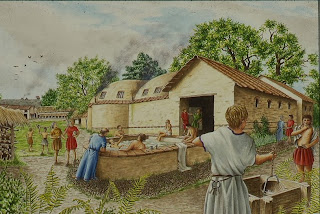Cheapside Bath House Very enjoyable Roman London Walk for London walks, yesterday. We started at Moorgate, which was a very good choice geographically. historically. I used a lot of Martial, Ovid, etc to make it more interesting. Of what does the happy life consist, My dear friend Julius? Here's a list: Inherited wealth no need to earn, Fires that continually burn, And fields that give a fair return, No lawsuits, formal togas worn Seldom, a calm mind, the freeborn Gentleman's health and good physique, Tact with the readiness to speak Openly, friends of your own mind, Guests of an easy-going kind, Plain food, a table simply set, Nights sober but wine-freed from fret, A wife who's true to you and yet No prude in bed, and sleep so sound It makes the day come quickly round. Be pleased with what you are, keep hope Within that self-appointed scope: Neither uneasily apprehend Nor morbidly desire the end. Martial,...





